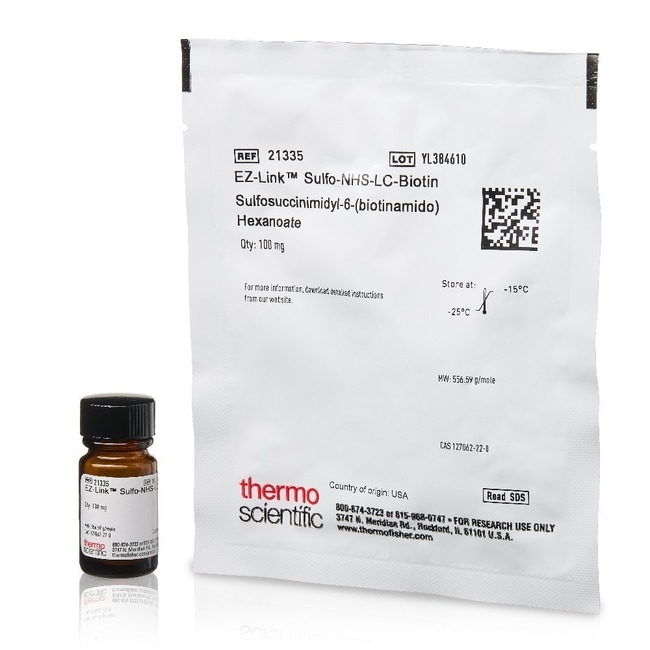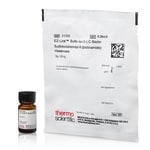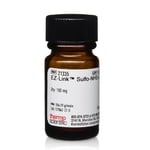Search Thermo Fisher Scientific
EZ-Link™ Sulfo-NHS-LC-Biotin
| Catalog Number | Quantity |
|---|---|
| 21335 | 100 mg |
| A39257 | 10 x 1 mg |
Features of EZ-Link Sulfo-NHS-LC-Biotin:
• Protein labeling—biotinylate antibodies to facilitate immobilization, purification or detection using streptavidin resins or probes
• Cell surface labeling—biotinylates only surface proteins of whole cells because the negatively charged reagent does not permeate cell membranes
• Amine-reactive—reacts with primary amines (-NH2), such as lysine side-chains, or the amino-termini of polypeptides
• Soluble—charged sulfo-NHS group increases reagent water solubility compared to ordinary NHS-ester compounds
• Irreversible—forms permanent amide bonds; spacer arm cannot be cleaved
• Medium length—spacer arm (total length added to target) is 22.4 angstroms; provides excellent balance between adequate length (minimal steric hindrance for biotin binding) and modest mass
Sulfo-NHS-LC-Biotin is one of three very similar EZ-Link Reagents that are water-soluble, non-cleavable, and enable simple and efficient biotinylation of antibodies, proteins and any other primary amine-containing macromolecules in solution. Specific labeling of cell surface proteins is another common application for these uniquely water-soluble and membrane impermeable reagents. Differing only in their spacer arm lengths, the three Sulfo-NHS-ester reagents offer the possibility of optimizing labeling and detection experiments where steric hindrance of biotin binding is an important factor. Sulfo-NHS-LC-Biotin is offered in several package sizes and as complete protein labeling kits.
We manufacture biotin reagents to ensure the highest possible overall product integrity, consistency, and performance for the intended research applications.
N-Hydroxysulfosuccinimide (NHS) esters of biotin are the most popular type of biotinylation reagent. NHS-activated biotins react efficiently with primary amino groups (-NH2) in alkaline buffers to form stable amide bonds. Proteins (e.g., antibodies) typically have several primary amines that are available as targets for labeling, including the side chain of lysine (K) residues and the N-terminus of each polypeptide.
Varieties of biotin NHS-ester reagents differ in length, solubility, cell permeability and cleavability. Non-sulfonated NHS-biotins are cell permeable but must be dissolved in organic solvent such as DMSO or DMF. Sulfo-NHS biotins (and those with pegylated spacers) are directly water soluble but not membrane permeable. Varieties containing disulfide bonds can be cleaved using reducing agents, enabling the biotin group to be disconnected from the labeled protein.
Related Products
EZ-Link™ Sulfo-NHS-LC-Biotinylation Kit
EZ-Link™ Micro Sulfo-NHS-LC-Biotinylation Kit
Pierce™ Premium Grade Sulfo-NHS-LC-Biotin
Figures


Customers who viewed this item also viewed
Documents & Downloads
Certificates
Safety Data Sheets
Frequently asked questions (FAQs)
No. NHS esters hydrolyze very quickly. The container must be brought to room temperature (RT) prior to opening, then the amount of biotinylation reagent weighed, dissolved and used immediately.
Find additional tips, troubleshooting help, and resources within our Protein Assays and Analysis Support Center.
Yes. Because this molecule dissolves readily in polar solutions and is itself charged by the sodium sulfoxide group on the succinimidyl ring, it cannot permeate the cell wall or membrane of an intact cell. As long as the cell is intact, only the primary amines on the surface will be biotinylated.
Find additional tips, troubleshooting help, and resources within our Protein Assays and Analysis Support Center.
Tris is a primary amine, which will directly compete with protein primary amines for reaction with the NHS-ester activated biotin reagent. However, once a protein is labeled and desalted, Tris buffer can be used for storage or assay buffers, as appropriate for the protein and application.
Find additional tips, troubleshooting help, and resources within our Protein Assays and Analysis Support Center.
The molar excess to use depends on the concentration of the ligand to be biotinylated. Although the literature contains references that use between 2-50 molar excess of biotin, we recommend the following: 10-fold molar excess for 10 mg/mL solution of protein; 25-fold molar excess for 2 mg/mL solution of protein.
Find additional tips, troubleshooting help, and resources within our Protein Assays and Analysis Support Center.
No, the EZ-Link Sulfo-NHS-LC-Biotin, No-Weigh Format (Cat. No. A39257) should not be dissolved in water for storage. We recommended storing EZ-Link Sulfo-NHS-LC-Biotin, No-Weigh Format at -20 degrees C with desiccant as it is very moisture sensitive. Furthermore, to avoid moisture condensation onto the product, equilibrate vial to room temperature before opening.
Find additional tips, troubleshooting help, and resources within our Protein Assays and Analysis Support Center.





